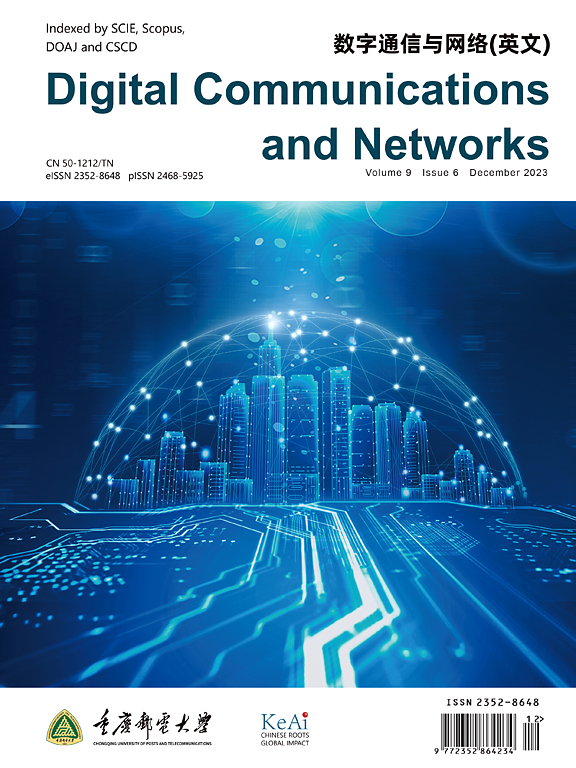Performance analysis of RIS-assisted dual-hop mixed FSO-RF UAV communication systems
IF 7.5
2区 计算机科学
Q1 TELECOMMUNICATIONS
引用次数: 0
Abstract
In this paper, we investigate a Reconfigurable Intelligent Surface (RIS)-assisted Free-Space Optics–Radio Frequency (FSO–RF) mixed dual-hop communication system for Unmanned Aerial Vehicles (UAVs). In the first hop, a source UAV transmits data to a relay UAV using the FSO technique. In the second hop, the relay UAV forwards data to a destination Mobile Station (MS) via an RF channel, with the RIS enhancing coverage and performance. The relay UAV operates in a Decode-and-Forward (DF) mode. As the main contribution, we provide a mathematical performance analysis of the RIS-assisted FSO–RF mixed dual-hop UAV system, evaluating outage probability, Bit-Error Rate (BER), and average capacity. The analysis accounts for factors such as atmospheric attenuation, turbulence, geometric losses, and link interruptions caused by UAV hovering behaviors. To the best of our knowledge, this is the first theoretical investigation of RIS-assisted FSO–RF mixed dual-hop UAV communication systems. Our analytical results show strong agreement with Monte Carlo simulation outcomes. Furthermore, simulation results demonstrate that RIS significantly enhances the performance of UAV-aided mixed RF/FSO systems, although performance saturation is observed due to uncertainties stemming from UAV hovering behavior.
ris辅助双跳混合FSO-RF无人机通信系统性能分析
本文研究了一种用于无人机的可重构智能表面(RIS)辅助自由空间光学-射频(FSO-RF)混合双跳通信系统。在第一跳中,源无人机使用FSO技术向中继无人机传输数据。在第二跳中,中继无人机通过射频信道将数据转发到目标移动站(MS), RIS增强了覆盖范围和性能。中继无人机以解码和转发(DF)模式操作。作为主要贡献,我们提供了ris辅助FSO-RF混合双跳无人机系统的数学性能分析,评估了中断概率,误码率(BER)和平均容量。该分析考虑了由无人机悬停行为引起的大气衰减、湍流、几何损失和链路中断等因素。据我们所知,这是ris辅助FSO-RF混合双跳无人机通信系统的第一个理论研究。我们的分析结果与蒙特卡罗模拟结果非常吻合。此外,仿真结果表明,RIS显著提高了无人机辅助混合RF/FSO系统的性能,尽管由于无人机悬停行为的不确定性导致性能饱和。
本文章由计算机程序翻译,如有差异,请以英文原文为准。
求助全文
约1分钟内获得全文
求助全文
来源期刊

Digital Communications and Networks
Computer Science-Hardware and Architecture
CiteScore
12.80
自引率
5.10%
发文量
915
审稿时长
30 weeks
期刊介绍:
Digital Communications and Networks is a prestigious journal that emphasizes on communication systems and networks. We publish only top-notch original articles and authoritative reviews, which undergo rigorous peer-review. We are proud to announce that all our articles are fully Open Access and can be accessed on ScienceDirect. Our journal is recognized and indexed by eminent databases such as the Science Citation Index Expanded (SCIE) and Scopus.
In addition to regular articles, we may also consider exceptional conference papers that have been significantly expanded. Furthermore, we periodically release special issues that focus on specific aspects of the field.
In conclusion, Digital Communications and Networks is a leading journal that guarantees exceptional quality and accessibility for researchers and scholars in the field of communication systems and networks.
 求助内容:
求助内容: 应助结果提醒方式:
应助结果提醒方式:


